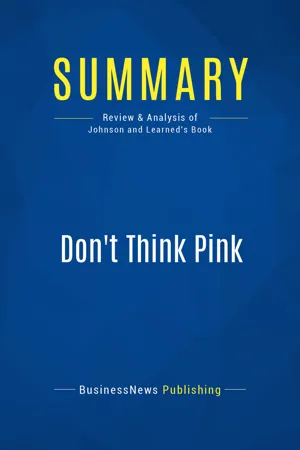
Summary: Don't Think Pink
Review and Analysis of Johnson and Learned's Book
- English
- ePUB (mobile friendly)
- Available on iOS & Android
About This Book
The must-read summary of Lisa Johnson and Andrea Learned's book: `Don't Think Pink: What Really Makes Women Buy and How to Increase Your Share of This Market`.
This complete summary of the ideas from Lisa Johnson and Andrea Learned's book `Don't Think Pink` shows that very few corporations purposefully attempt to target women to purchase their products, despite the fact that women make or influence 80% of all purchase decisions. Furthermore, those who do target women end up using stereotypical and superficial methods, like offering their product in pink. In their book, the authors reveal the real reasons why women decide to make purchases and the marketing techniques that will really get their attention. By reading this summary, you will understand how to adapt your marketing techniques to target female consumers and avoid clichés.
Added-value of this summary:
• Save time
• Understand key concepts
• Expand your marketing skills
To learn more, read `Don't Think Pink` and discover the secrets to marketing to female consumers.
Frequently asked questions
Information
Summary of Don’t Think Pink (Lisa Johnson and Andrea Learned)
The Ultimate Goal: The right-hand side of the marketing spectrum
- Women now earn about $1 trillion a year in wages and income – an increase of 63-percent over the past decade. This has been fueled by:
- A shrinking wage gap between men and women.
- More women earning advanced degrees.
- Skilled women out earning their less-competent husbands.
- More women starting or buying businesses.
- Women living longer and having a higher net worth.
- Women are responsible for the bulk of consumer purchases – about 80-percent of all consumer buying according to research. In fact, studies suggest women write 80-percent of all personal checks. In all, women account for more than $2 trillion in annual spending.
- Around 51-percent of all corporate purchasing agents are now women – meaning they have a large say in corporate spending as well as household spending preferences and decisions.
- The women’s market is now too big to be treated as a niche – but must be viewed as a huge market which can and should be segmented intelligently rather than being lumped together into the one category.
- Pink thinking – early efforts to reach women were sincere but lacking in knowledge. Many companies bought out feminine or flowery versions of their products, thinking these would automatically appeal to women. Pink thinking relied heavily on stereotypes and grouped all women customers into the one segment.
- Gender-neutral marketing – which works on the premise men and women aren’t all that different and therefore should be marketed to with the same materials. This usually ends up turning off both male and female consumers.
- Visible women’s marketing – where the product is obviously directed to the female customer. This would be along the lines of the Venus Razor by the Gillette Company where the product is obviously for women, and the marketing underlies that orientation.
- Transparent women’s marketing – where companies do things that women will respond to without labeling the product or services as being specifically for women. For example, Home Depot is now widening its aisles and changing its displays to appeal to women’s interests. (Women like more room to browse and to examine products on the lower shelves). This type of marketing acknowledges that women think differently and caters to those needs without being obvious or painting everything pink.
- Hybrid women’s marketing – where the bulk of the marketing effort is transparent but certain products or elements are more visibly focused on attracting female purchasers. For example, a bakery recently introduced “Women’s Bread” which features ingredients that specifically address women’s health concerns.

- Narrow your focus – and appeal to those women who are most likely to become your early adopters. Start with this group alone rather than trying to market to all...
Table of contents
- Title page
- Book Presentation
- Summary of Don’t Think Pink (Lisa Johnson and Andrea Learned)
- About the Summary Publisher
- Copyright